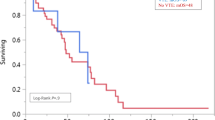Abstract
Deep venous thrombosis (DVT) has been variably reported in multiple myeloma patients during treatment with thalidomide alone or in combination with chemotherapy or dexamethasone. With the aim of investigating this complication, we performed, on a cohort of 13 relapsed refractory MM patients treated with low-dose thalidomide (100 mg/day) and dexamethasone (20 mg p.o./day for 4 days every 2 weeks), a serial evaluation of different laboratory parameters implicated in DVT. No significant abnormalities in all genetic, serologic, or plasmatic parameters studied were registered, apart from thrombomodulin which showed significant variations between baseline and 1st-month values and 1st- and 3rd-month values. In conclusion, the evidence of significant variations of thrombomodulin values in the 1st month of therapy, which is considered to involve the highest risk of thrombosis, might support a role for thrombomodulin in this complex mechanism.
Similar content being viewed by others
References
Cavenagh JD, Oakervee H (2003) Thalidomide in multiple myeloma: current status and future prospects. Br J Haematol 120:18–26
Rajkumar SV, Hayman S, Gertz MA, Dispenzieri A, Lacy MQ, Greipp PR, Geyer S, Iturria N, Fonseca R, Lust JA, Kyle RA, Witzig TE (2002) Combination therapy with thalidomide plus dexamethasone for newly diagnosed myeloma. J Clin Oncol 20:4319–4323
Zangari M, Anaissie E, Barlogie B, Badros A, Desikan R, Gopal AV, Morris C, Toor A, Siegel E, Fink L, Tricot G (2001) Increased risk of deep-vein thrombosis in patients with multiple myeloma receiving thalidomide and chemotherapy. Blood 98:1614–1615
Zangari M, Siegel E, Barlogie B, Anaissie E, SaghafifarF, Fassas A, Morris C, Fink L, Tricot G (2002) Thrombogenic activity of doxorubicin in myeloma patients receiving thalidomide: implication for therapy. Blood 100(4):1168–1171
Falanga A, Donati MB (2001) Pathogenesis of thrombosis in patients with malignancy. Prog Hematol 73:137–144
Zangari M, Saghafifar F, Anaissie E, Badros A, Desikan R, Fassas A, Mehta P, Morris C, Toor A, Whitfield D, Siegel E, Barlogie B, Fink L, Tricot G (2002) Activated protein C resistance in the absence of factor V Leiden mutation is a common finding in multiple myeloma and is associated with an increased risk of thrombotic complications. Blood Coagul Fibrinolysis 13(13):187–192
Zangari M, Saghafifar F, Mehta P, Barlogie B, Fink L, Tricot G (2003) The blood coagulation mechanism in multiple myeloma. Semin Thromb Hemost 29(3):275–282
Singhal S, Mehta J, Desikan R, Dan Ayers MS, Roberson P, Eddlemon P, Munshi N, Anaissie E, Wilson C, Dhodapkar M, Zeldis J, Barlogie B (1999) Antitumor activity of thalidomide in refractory multiple myeloma. N Engl J Med 341:1565–1571
Camba L, Peccatori J, Pescarollo A, Tresoldi M, Corradini P, Bregni M (2001) Thalidomide and thrombosis in patients with multiple myeloma. Haematologica 86:1108
Osman K, Comenzo R, Rajkumar SV (2001) Deep venous thrombosis and thalidomide therapy for multiple myeloma. N Engl J Med 344(25):1951–1952
Santos AB, Llamas P, Roman A, PrietoE, de Ona R, de Velasco JF, Tomas JF (2003) Evaluation of thrombophilic states in myeloma patients receiving thalidomide: a reasonable doubt. Br J Haematol 122:159–160
Kaushal V, Kohli M, Zangari M, Fink L, Metha P (2002) Endothelial dysfunction in antiangiogenesis-associated thrombosis. J Clin Oncol 20(13):3042–3043
Esmon CT (1989) The roles of protein C and thrombomodulin in the regulation of blood coagulation. J Biol Chem 2644:4743
Marchant KK, Comp P (2002) Laboratory issue in diagnosing abnormalities of protein C, thrombomodulin and endothelial cell protein C receptor. Arch Pathol Lab Med 126:1337–1348
Ishii H, Uchiyama H, Kazama M (1991) Soluble thrombomodulin antigen in conditioned medium is increased by damage of endothelial cells. Thromb Haemost 65:6118–6125
Author information
Authors and Affiliations
Corresponding author
Rights and permissions
About this article
Cite this article
Corso, A., Lorenzi, A., Terulla, V. et al. Modification of thrombomodulin plasma levels in refractory myeloma patients during treatment with thalidomide and dexamethasone. Ann Hematol 83, 588–591 (2004). https://doi.org/10.1007/s00277-004-0891-6
Received:
Accepted:
Published:
Issue Date:
DOI: https://doi.org/10.1007/s00277-004-0891-6



